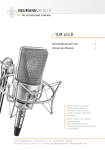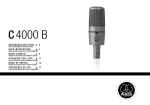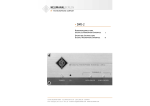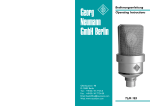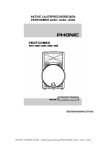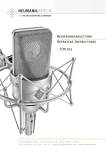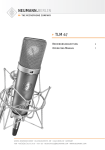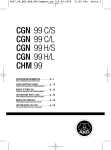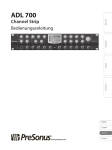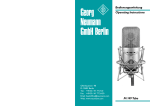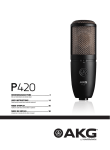Download Neumann.Berlin D-01 User's Manual
Transcript
D-01 Bedienungsanleitung digitales mikrophon 2 Operating Instructions digital microphone 8 georg neumann gmbh · ollenhauerstr. 98 · 13403 berlin · germany fon +49 (0)30 / 41 77 24-0 · fax -50 · [email protected] · www.neumann.com 1. geschlossen wird. Das D-01 ist gegen Überspannung geschützt und verträgt kurzzeitig bis +55 V.) Einleitung In dieser Anleitung finden Sie alle wichtigen Informationen für den Betrieb und die Pflege des von Ihnen erworbenen Mikrophons. Lesen Sie diese Anleitung und die der dazugehörigen Geräte bitte sorgfältig und vollständig, bevor Sie es benutzen. Bewahren Sie die Anleitung bitte so auf, dass sie für alle momentanen und späteren Nutzer jederzeit zugänglich ist. • Reparatur- und Servicearbeiten dürfen nur von erfahrenem und autorisiertem Fachpersonal durchgeführt werden. Wenn Sie das Mikrophon eigenmächtig öffnen oder umbauen, erlischt die Gewährleistung. • Verwenden Sie das Mikrophon nur in dem in den technischen Daten angegebenen Leistungsbereich. • Lassen Sie das Mikrophon auf Umgebungstemperatur akklimatisieren, bevor Sie es einschalten. • Nehmen Sie das Mikrophon nicht in Betrieb, wenn es beschädigt ist. • Verlegen Sie Kabel stets so, dass niemand darüber stolpern kann. • Halten Sie Flüssigkeiten vom Mikrophon und dessen Anschlüssen fern. • Verwenden Sie zum Reinigen keine Lösungsmittel oder aggressiven Reinigungsmittel. • Entsorgen Sie das Mikrophon nach den Bestimmungen Ihres Landes. Weitergehende Informationen, insbesondere auch zu den verfügbaren Zubehörteilen und den Neumann-Servicepartnern, finden Sie auf unserer Website www.neumann.com. Die Servicepartner können Sie auch telefonisch unter +49 (0) 30 / 41 77 24 – 0 erfragen. Auf unserer Website www.neumann.com finden Sie in der Rubrik Downloads ergänzend folgende PDF-Dateien: • Hinweise zur Pflege des Mikrophons • Bedienungsanleitung DMI-2 (Digitales Mikrophon-Interface) • Bedienungsanleitung RCS (Remote Control Software) • Kurzbeschreibung des Standards AES 42 Weitergehende Informationen zur Schnittstelle digitaler Mikrophone finden Sie bei www.aes.org/ standards unter „AES 42-2006: AES standard for acoustics – Digital interface for microphones“. Zum weltweiten Erfahrungsaustausch unter Neumann-Anwendern bieten wir das Neumann Online-Forum an, das sich durch die integrierte Archivfunktion zu einem umfangreichen KnowHow-Pool entwickelt hat. 2. Das D-01 ist ein Studio-Kondensatormikrophon mit digitalem Ausgang gemäß dem internationalen Standard AES 42. Dieser basiert auf dem in Studiogeräten üblichen Standard AES 3 (AES/EBU) für digitale Audiosignale, erweitert um die Phantomspeisung für das Mikrophon, um Fernsteuerund Synchronisationsdaten sowie um User-Bits zum Empfang von Mikrophon-Steuerdaten. Das D-01 ist ein Großmembranmikrophon mit umschaltbarer Richtcharakteristik, von Kugel, breite Niere, Niere, Hyperniere bis Acht, sowie 10 weiteren Zwischenstellungen. Sicherheitshinweise Die Einsprechrichtung des Mikrophons ist seitlich, die Vorderseite wird durch das Neumann-Emblem gekennzeichnet. Schließen Sie das Mikrophon nur an Mikrophoneingänge und Speisegeräte an, die eine Phantomspeisung nach AES 42 liefern. (Das Mikrophon wird jedoch nicht beschädigt, falls es versehentlich kurzzeitig an einen analogen Mikrophoneingang mit 48 V-Phantomspeisung an- 2 Beschreibung Registrieren Sie bitte Ihr System auf der Website www.my-Solution-D.com, um jederzeit über Updates informiert zu werden! Der bestimmungsgemäße Gebrauch dieses Mikrophons ist die Wandlung akustischer in digitale elektrische Signale. D 3. Bei der im Mikrophonkorb elastisch gelagerten Großmembrankapsel handelt es sich um die ebenfalls neu entwickelte Kapsel K 07. Die K 07 im Zusammenhang mit der MikrophonEingangsschaltung und der neuartigen Wandlertechnologie ist das erste Doppelmembransystem, das einen Ersatzgeräuschpegel von nur 8 dB-A bietet. Das Mikrophon zeichnet sich aus durch besonders saubere und verfärbungsfreie Klangübertragung bei sehr niedrigem Eigengeräuschpegel und gleichzeitig höchster Aussteuerbarkeit. Es verwendet zur Digitalisierung ein von Neumann entwickeltes und patentiertes A/D-Wandlungsverfahren. Dadurch ist sichergestellt, dass der gesamte Dynamikumfang der Kapselsignale in die digitale Ebene überführt wird. Mit der integrierten digitalen Signalverarbeitung bietet das Mikrophon außerdem Funktionen, die bisher nur im Mischpult oder zusätzlichen Geräten realisiert werden konnten. Diese Funktionen werden im Kapitel Technische Daten beschrieben. Der Kapseldurchmesser beträgt 30 mm, die Dicke des Kapselsystems 4,5 mm. Beide Membranen liegen dicht an der Kapsel-Oberfl äche, um interne Laufzeiten des Schalls, seine Wege um das Kapselsystem herum sowie Reflexionen an den Membran-Spannringen zu minimieren. Das Ergebnis sind sehr flache, ausgeglichene Frequenzgänge für alle 15 im Mikrophon D-01 wählbaren Richtcharakteristiken. Im oberen Formantbereich ab 3 kHz ist die Kapsel breitbandig etwa 2 dB empfindlicher als in den Lagen darunter. Dies gibt ihr einen frischen, offenen Klang ohne Verfärbungen. Die K 07 arbeitet mit einem besonders kleinen Membranabstand. Dieser sorgt für eine wirksame, rein akustische Bedämpfung des Systems. Da zum Erreichen der Mikrophoneigenschaften keine Resonanzwirkungen genutzt werden, ist das Impulsverhalten des Mikrophons ausgezeichnet, und es vermag alle Ausgleichsvorgänge in Musik und Sprache unverfälscht zu übertragen. Die Kapsel ist zum Schutz gegen Körperschallübertragung elastisch gelagert. Durch den bis unter 20 Hz linear verlaufenden Frequenzgang des D-01 können auch extrem niederfrequente Signale unverfälscht übertragen werden. Andererseits ist das Mikrophon dadurch auch empfindlich für tieffrequente Störsignale wie Körperschall, Poppund Windgeräusche. Bei eventuellen Störungen empfiehlt es sich daher, entweder den Frequenzgang im unteren Bereich zu beschneiden (siehe Abschnitt 4.2, Software-Funktionen) und/oder einen Popschirm PS 20 a oder einen Windschutz WS 47 zu verwenden (siehe Zubehör, Kapitel 7). Die Richtcharakteristik der Kapsel kann über die RCS-Software in 15 Stufen verändert und das Mikrophon damit besonders feinfühlig den Aufnahmegegebenheiten angepasst werden. Der 3-polige XLR-Ausgang des Mikrophons ist nach AES 42 beschaltet und mechanisch kompatibel zu der bekannten analogen Anschlusstechnik. Dies hat den Vorteil, dass analoge Mikrophonkabel bis zu einer mittleren Entfernung von etwa 100 m eingesetzt werden können. Bei versehentlichem Aufstecken auf einen phantomgespeisten analogen Mikrophoneingang ist das D-01 durch eine Überspannungsschutzschaltung gegen Beschädigung geschützt. Steht zum Anschluss des Mikrophons kein AES 42Eingang (z. B. am Mischpult) zur Verfügung, bietet Neumann das zweikanalige Digitale MikrophonInterface (DMI-2) mit der dazugehörigen Steuersoftware RCS zur Fernsteuerung aller Mikrophoneigenschaften an (siehe auch Kapitel Technische Daten). 4. Inbetriebnahme Mikrophon einrichten Befestigen Sie das Mikrophon auf einem ausreichend stabilen und standfesten Stativ. Verwenden Sie ggf. eine elastische Aufhängung, um die Übertragung von Körperschallgeräuschen mechanisch zu unterdrücken. Setzen Sie dafür das Mikrophon von oben in den Innenkorb ein und schrauben Sie es mit der Rändelmutter am Innenkorb fest. Zur Dämpfung von Wind- oder Popgeräuschen verwenden Sie bei Bedarf einen Wind- oder Popschutz aus unserem Zubehörprogramm. Mikrophon anschließen Vorsicht: Eine falsche Versorgungsspannung kann das Mikrophon beschädigen! Schließen Sie das Mikrophon nur an Mikrophoneingänge und Speisegeräte an, die eine Phantomspeisung nach AES 42 liefern. Siehe auch Kapitel „Sicherheitshinweise“. Vorsicht: Sehr hohe Signalpegel können Ihr Gehör und Ihre Laut sprecher schädigen! Reduzieren Sie an den angeschlossenen Wiedergabegeräten die Lautstärke, bevor Sie das Mikrophon anschließen, auch wegen der Gefahr der akustischen Rückkopplung. 3 D Verbinden Sie das Mikrophon über ein XLR-Kabel mit dem AES 42-Mikrophoneingang Ihres Digitalen Mikrophon-Interface DMI-2 (siehe auch die Anleitungen für DMI-2 und RCS) oder eines anderweitigen Audiogerätes nach AES 42. verschoben. Während des Umladens ist das Mikrophon kurzzeitig stumm geschaltet. Gain: Die Verstärkung erfolgt ausschließlich auf der digitalen Ebene und führt damit nicht zu der aus der analogen Signalbearbeitung bekannten Rauschaddition und zu möglichen Klangbeeinflussungen. Das Schalten erfolgt knackfrei. Eine blaue LED im Mikrophon zeigt bei korrekter Speisung die Betriebsbereitschaft an. Sie leuchtet beim Einschalten zunächst schwach und nach kurzer Zeit mit der voreingestellten Helligkeit. Diese kann bei Verwendung des Digitalen Mikrophon-Interfaces DMI-2 mit der Remote Control Software in vier Stufen variiert und ausgeschaltet werden. Peak-Limiter: Der sehr schnelle Peak-Limiter hat eine einstellbare Ansprechschwelle und verhindert Übersteuerungen bzw. Clippen des Audiosignals im Signalweg. Kompressor/Limiter: Weiterhin ist ein vollständig parametrisierbarer Kompressor/Limiter implementiert. Dieser kann breitbandig oder als Hochtonkompressor/Limiter (De-Esser) in einem von drei wählbaren Frequenzbereichen arbeiten. Alle wichtigen Parameter sind einstellbar. Achten Sie beim Anschließen von Kabeln auf die korrekte Verriegelung der Steckverbinder. Lange Kabel und mehrfache Steckverbindungen führen zu einem Spannungsabfall der Speisespannung und zu einer Verschlechterung des JitterVerhaltens insbesondere bei hohen Abstastraten. Verwenden Sie daher möglichst durchgehende Kabelverbindungen zwischen Mikrophon und Folgegerät und bei größeren Distanzen ausschließlich AES/EBU-Kabel (Wellenwiderstand 110 Ohm). Achten Sie darauf, dass das Mikrophon und alle Geräte der digitalen Signalkette synchronisiert sind. Wird das Digitale Mikrophon-Interface von Neumann verwendet, sollten die angeschlossenen Mikrophone immer im Synchronmode (Mode 2) betrieben werden, unabhängig davon, ob in der nachfolgenden Signalkette Sample Rate Converter im Einsatz sind. Auf diese Weise wird im DMI eine sehr effektive Jitterunterdrückung wirksam. Auch ist die Ausgabe zweier Mikrophonsignale in einem AES 3-Stereosignal nur möglich, wenn die Mikrophone untereinander synchron laufen. Parameter, die über die AES 42-Schnittstelle ferngesteuert werden können Richtcharakteristik: Die Umschaltung der Richtcharakteristik wird durch Veränderung der Polarisationsspannung der hinteren Kapselhälfte realisiert. Während des Umladens ist das Mikrophon kurzzeitig stumm geschaltet. Low Cut: Der Low Cut bietet gemäß AES42-Standard die vier Einstellungen: off, 40 Hz, 80 Hz und 160 Hz. Vordämpfung: Die Vordämpfung wird durch Reduktion der Kapselspannung realisiert. Bei Aktivierung wird der Dynamikbereich um den entsprechenden Wert zu höheren Schalldrücken D 4 Außerdem lassen sich die Abtastrate, der Synchronisationsmodus, Testsignale, die Polarität und Stummschaltung des Ausgangssignals und die LEDs fernsteuern. Die Software im Mikrophon kann über das Neumann DMI-2 aktualisiert werden, so dass Erweiterungen der Software auch bestehenden Kunden zur Verfügung stehen. Zu Details des Updates lesen Sie bitte die RCS-Anleitung. 5. Außerbetriebnahme und Aufbewahrung Ziehen Sie beim Lösen von Kabeln stets nur an den Steckverbindern und nicht am Kabel. Mikrophone, die längere Zeit nicht verwendet werden, sollten bei normalem Umgebungsklima staubgeschützt aufbewahrt werden. Verwenden Sie hierfür einen nicht fusselnden, luftdurchlässigen Staubschutzbeutel oder die Originalverpackung des Mikrophons. 6. Technische Daten Fernsteuerbare Funktionen 1) Zulässige klimatische Verhältnisse: Betriebstemperaturbereich.............. 0 °C … +40 °C Lagerungstemperaturbereich ...... –20 °C … +70 °C Feuchtebereich ......................0 % … 99 % rel. hum. bei +20 °C 0 % … 95 % rel. hum. bei +60 °C Vordämpfung .............................. 0/–6/–12/–18 dB Hochpassfilter ........................... Off/40/80/160 Hz Digitale Signalverstärkung .......................0...63 dB in 1 dB-Schritten, knackfrei Testsignal ............................ Off, 1 kHz (–48 dBFS), rosa Rauschen (–35 dBFS), weißes Rauschen (–43 dBFS) Akust. Arbeitsweise ................... DoppelmembranDruckgradientenempfänger Richtcharakteristik ................Kugel...Niere...Acht, insgesamt 15 Stellungen Übertragungsbereich ......................20 Hz...20 kHz Feldübertragungsfaktor2) ....................... –44 dBFS Kompressor/Limiter ......................................On/Off Untere Grenzfrequenz des Arbeitsbereichs ...........Flat/1 kHz/2 kHz/4 kHz Max. Dämpfung (gain reduction): flat mode ....................................................... > 63 dB 1 kHz/2 kHz/4 kHz ........................................ > 20 dB Ratio ............................................... 1,2:1/1,5:1/2:1/ 3:1/4:1/6:1/8:1/>100:1 Threshold .........................–63 dBFS..–10...0 dBFS, in 1 dB Stufen Attack time ..............0/0,1/0,3/1/3/10/30/100 ms Release time .................. 0,05/0,1/0,2/0,5/1/2/5 s Ersatzgeräuschpegel, CCIR4) ...............................................................19 dB Ersatzgeräuschpegel, A-bewertet4) ..................................................8 dB-A Geräuschpegelabstand3), CCIR4) ...............................................................75 dB Geräuschpegelabstand3), A-bewertet4) ................................................... 86 dB Grenzschalldruckpegel bei 0 dBFS ............................................. 138 dBSPL Dynamikumfang4) .........................................130 dB A/D-Wandlung ........................Neumann-Verfahren (patentiert), 28 Bit interne Wortbreite Digitale Signalverarbeitung ......Fixpoint, variable interne Wortbreite, 28...60 Bit Abtastraten ......................................44,1/48/88,2/ 96/176,4/192 kHz Ausgangsdatenformat ...........24 Bit nach AES/EBU (AES 3) Bei 0 dB Vordämpfung und 0 dB Gain. 1) Alle Werte für nicht-kondensierende Feuchtigkeit. 2) bei 1 kHz, 0 dB Verstärkung und 94 dB SPL 3) bezogen auf 94 dB SPL 4) nach IEC 60268-1; CCIR-Bewertung nach CCIR 468-3, Quasi-Spitzenwert; A-Bewertung nach IEC 61672-1, Effektivwert (bezogen auf eine Pegeländerung von ca. 10 dB ) Peak-Limiter...................................................On/Off Attack time ...................................–160 µs (negativ) Release time ............................. ca. 50 ms...150 ms (signalabhängig) Threshold ........................................Off: 0 dBFS fest On: –15 dBFS...0 dBFS, in 1 dB-Stufen Mute................................................................On/Off Phase (Polarität) ......................................... 0, 180° Anzeige .............................LED 1 (rot), LED 2 (blau), Helligkeit einstellbar Abtastraten .......44,1/48/88,2/96/176,4/192 kHz Latenzzeit: 44,1/48 kHz .......................................... 52 Samples 88,2/96 kHz.......................................... 61 Samples 176,4/192 kHz......................................121 Samples Synchronisation: asynchroner Betrieb (freilaufend), Frequenz-Grundgenauigkeit.................... ± 25 ppm synchroner Betrieb, Ziehbereich .................................... min. ± 100 ppm Stromversorgung (Phantomspeisung gemäß AES 42) Speisespannung .................................. +6...+10,5 V Stromaufnahme ..................................max. 220 mA Steckverbinder ............................................ XLR 3 M Abmessungen ...............................Ø 63,5 x 185 mm Gewicht ...........................................................700 g 5 D 7. Zubehör* (Fotos im Anhang) Elastische Aufhängung EA 2 ..........................ni ................ Best.-Nr. 008432 Tisch- und Fußbodenständer MF 3 .........................sw ............... Best.-Nr. 007321 MF 4 .........................sw ............... Best.-Nr. 007337 MF 5 .........................gr ................ Best.-Nr. 008489 Mikrophonneigevorrichtung MNV 87 ....................ni ................ Best.-Nr. 006804 Stativgelenke, weitere mechanische Adapter DS 120 .....................sw ............... Best.-Nr. 007343 SG 1 ..........................sw ............... Best.-Nr. 008445 Popschutz PS 15 .......................sw ............... Best.-Nr. 008472 PS 20 a ...................sw ............... Best.-Nr. 008488 Anschlusskabel IC 3 mt .....................sw ............... Best.-Nr. 006543 IC 4 ..........................ni ................ Best.-Nr. 006547 D 6 Fehlercheckliste* Fehler ▶ Mögliche Ursachen ▶ Abhilfe Keine Funktion / Keine Signalübertragung Speisespannung fehlt Überprüfen Sie das Speisegerät und ggf. die zugehörigen Software-Einstellungen (RCS -> System -> MicPWR). Das Mikrophon ist nicht mit einem AES 42-Eingang verbunden Verwenden Sie einen AES 42–Eingang. Das Mikrophon ist nicht mit dem richtigen Kanal verbunden Überprüfen Sie den Signalweg. Der Kanal ist gemutet Deaktivieren Sie Mute in der AES 42-Fernsteuerung. Zu hohe Schalldrücke im aufzunehmenden Tonsignal Vergrößern Sie den Aufnahmeabstand oder aktivieren Sie die Vordämpfung in Ihrer AES 42-Fernsteuerung. Übersteuerung durch tieffrequente Störgeräusche (Trittschall, Wind) Benutzen Sie einen geeigneten Windschutz (Zubehör). Aktivieren Sie die Vordämpfung in Ihrer AES 42-Fernsteuerung. Bedeutung der Farbcodierungen: ni = nickel, sw = schwarz, gr = grau * Ausführliche Beschreibungen und weitere Artikel finden Sie in unserem Zubehörkatalog oder unter www.neumann.com Ton verzerrt / schlechte Signalqualität Schaumstoff windschutz WS 47 .......................sw ............... Best.-Nr. 006826 8. 9. Lieferumfang Mono-Set Stereo-Set Mikrophon Mikrophon D-01 2 Mikrophone D-01 Mikrophon D-01 Elast. Aufhängung EA 2 2 Elast. Aufhängungen EA 2 Interface DMI-2 Interface DMI-2 Adapter USB 485 Adapter USB 485 Bedienungsanleitungen Bedienungsanleitungen Bedienungsanleitung Aluminiumkoffer Aluminiumkoffer Holzetui Kabel IC 3 2 Kabel IC 3 Kabel RJ 45 Kabel RJ 45 Kabel BNC Kabel BNC Kabel USB Kabel USB Netzkabel Netzkabel Aktivieren Sie ggf. den entsprechenden Eingang auf dem zugeordneten Kanalzug des Mischpults. Benutzen Sie einen geeigneten Popschutz (Zubehör). Aktivieren Sie die Vordämpfung in Ihrer AES 42-Fernsteuerung. * Weitere Fehlermöglichkeiten sind in der Bedienungsanleitung zum DMI-2 erläutert. 7 D 1. Introduction This manual contains essential information for the operation and care of the microphone you have purchased. Please read these instructions and those of the connected devices carefully and completely before using the product. Please keep this manual where it will be accessible at all times to all current and future users. Additional information, in particular concerning available accessories and Neumann service partners, can be found on our website: www.neumann.com. Information about service partners can also be obtained by telephone: +49 (0) 30 / 41 77 24 - 0. The following related files are available in PDF format in the Downloads section of our website www.neumann.com: • Some Remarks on Microphone Maintenance • DMI-2 Digital Microphone Interface Operating Manual • RCS Remote Control Software Operating Manual • Short description of the AES 42 standard Additional information concerning the digital microphone interface can be found on the website: www.aes.org/standards “AES 42-2006: AES standard for acoustics – Digital interface for microphones”. Our Neumann online forum enables Neumann users worldwide to share their experiences. Through its integrated archive function, the forum has developed into an extensive knowledge pool. Please register your system on the website www. my-Solution-D.com, to be informed whenever updates are available! 2. Safety instructions The microphone has the intended purpose of converting acoustic signals into digital electrical signals. EN 8 3. can handle a voltage of up to +55 V for a short period.) to reduce reflections from the rings tensioning the diaphragm. • Repairs and servicing are to be carried out only by experienced, authorized service personnel. Unauthorized opening or modification of the microphone shall void the warranty. • Use the microphone only under the conditions described in the Technical Data. • Allow the microphone to adapt to the ambient temperature before switching it on. • Do not operate the microphone in a damaged condition. • Always run cables in such a way that there is no risk of tripping over them. • Ensure that liquids are kept at a safe distance from the microphone and its connections. • Do not use solvents or aggressive cleansers for cleaning purposes. • Dispose of the microphone in accordance with the regulations applicable to the respective country. The resulting frequency responses of the D-01 microphone are very flat and smooth for all 15 available polar patterns. Description The D-01 is a studio condenser microphone with a digital output that complies with the international standard AES 42. Based upon the usual AES 3 (AES/EBU) standard for digital audio signals in studio equipment, this standard has been extended to include phantom power for the microphone, remote control and synchronization data, and user bits for receiving microphone control data. The D-01 is a large diaphragm microphone with switchable polar pattern: omni, wide cardioid, cardioid, hypercardioid, figure-8, as well as 10 intermediate settings. The microphone is addressed from the side. The front side is designated by the Neumann logo. The capsule is the newly developed K 07 large diaphragm capsule. It is elastically mounted inside the microphone head grille. Connect the microphone only to microphone inputs and to equipment which supplies phantom power in accordance with AES 42. The K 07, together with the microphone input circuitry and the new A/D conversion technology, is the first double diaphragm system to provide an equivalent self noise level of only 8 dB-A. (But the microphone will not be damaged if it is accidentally connected to an analog microphone input with a phantom power of 48 V for a short period. The D-01 has overvoltage protection and The capsule diameter is 30 mm, and the thickness of the capsule system is 4.5 mm. Both diaphragms lie very close to the capsule surface in order to minimize internal and external path lengths, and of the capsule signal is transferred to the digital domain. The integrated digital signal processing also provides functions which were previously available only via a mixing console or additional studio equipment. These functions are described in the “Technical data” section. In the upper formant range above 3 kHz the capsule is more sensitive by approximately 2 dB. This ensures a fresh, open sound character without coloration. The K 07 operates with an especially small distance between diaphragms and electrodes. This provides for an efficient, purely acoustical damping of the system. As the microphone characteristics are obtained without resorting to corrective resonance effects, the impulse response of the microphone is excellent, and it transmits all transient signals in music and speech without any coloration. The capsule is mounted elastically to attenuate vibration noise. Since the frequency response of the D-01 is linear down to below 20 Hz, even very low frequency signals can be transmitted without coloration. However this implies that the microphone is also sensitive to low frequency noise signals such as structure-borne, pop and wind noise. To avoid interference it is therefore advisable to use the microphone low cut filter (see Section 4.2 ”Software Functions“) and/or to use a PS 20 a pop screen or a WS 47 windscreen (see Section 7 ”Accessories“). The directional characteristic of the capsule can be set to any of 15 polar patterns via RCS-software, allowing a particularly fine adjustment of the microphone to recording conditions. If there is no microphone input according to AES 42 standard available Neumann provides the two-channel Digital Microphone Interface (DMI-2) with the accompanying RCS control software for remote controlling all microphone characteristics (see also the “Technical data” section). 4. Setup Mounting the microphone Attach the microphone to a stable, sturdy stand. Use an elastic suspension, if necessary, for the mechanical suppression of structure-borne noise. For this purpose set the microphone into the inner cage from above, and secure it to the inner cage with the threaded nut. If required, use a windscreen or popscreen from our range of accessories in order to suppress wind or pop noise. Connecting the microphone Caution: An incorrect supply voltage can damage the microphone! Connect the microphone to microphone inputs and to equipment which supplies phantom power in accordance with AES 42. See also chapter “Safety Instructions”. Caution: Very high signal levels can damage loudspeakers and your hearing! The 3-pin XLR output of the microphone is configured according to AES 42-2001 and is mechanically compatible with the similar connections of analog microphones. This has the advantage of allowing analog microphone cables to be used for runs of up to approximately 100 m. Over-voltage protection prevents damage to the D-01 in the event that it is inadvertently connected to a phantom-powered analog microphone input. Reduce the volume of connected playback equipment before connecting the microphone. This is also advisable in order to avoid acoustic feedback. The microphone features exceptionally clean sound transmission which is free of coloration, with very low self-noise and an extensive dynamic range. Digitization is performed by an A/D conversion process developed and patented by Neumann. This ensures that the full dynamic range With a correct power supply, a blue LED on the microphone indicates that the microphone is ready to operate. After switching on, the LED at first glows dimly, and after a short time shines with the preset brightness. When the DMI-2 Digital Microphone Interface is used with the Remote Con- Connect the microphone by means of an XLR cable to the AES 42 microphone input of the DMI-2 Digital Microphone Interface (see also DMI-2 and RCS manuals) or to other audio equipment complying with the AES 42 standard. 9 EN trol Software, the LEDs can be set to four different brightness levels or switched off. (de-esser) in one of three selectable frequency ranges. All important parameters are adjustable. When connecting the cables, ensure that the connectors are locked correctly. In addition, the sampling rate, the synchronization mode, test signals, the polarity and muting of the output signal and the LEDs can be controlled remotely. Long cables and multiple connectors lead to a drop in the supply voltage and to a deterioration in jitter behavior, particularly in the case of high sampling rates. Therefore, to the greatest extent possible, use continuous cable between the microphone and subsequent equipment, and for longer distances use AES/EBU cable exclusively (with an impedance of 110 ohms). Ensure that the microphone and all equipment in the digital signal chain are synchronized. If the Neumann Digital Microphone Interface is used, the connected microphones should always be operated in synchronous mode (Mode 2), whether or not sample rate converters are used in the subsequent signal chain. This will ensure very effective jitter suppression in the DMI. Also, the output of two microphone signals as one AES 3 stereo signal is possible only if the microphones are synchronized with one another. Parameters which can be remote controlled via the AES 42 interface Polar pattern: Switching the polar pattern is achieved by varing the polarization voltage of the rear capsule half. During the reloading process the microphone is temporarily muted. Low Cut: Acccording to AES42 there are four setting for the low cut: off, 40 Hz, 80 Hz and 160 Hz. Pre-attenuation: Pre-attenuation is achieved by reducing the capsule voltage. If pre-attenuation is activated, the dynamic range is shifted by the corresponding value to higher sound pressure levels. During the reloading process the microphone is temporarily muted. Gain: Gain is carried out exclusively in the digital domain, thus avoiding the additional noise and possible effects on the sound which can occur in analog processing. The switching process is clickless. Peak limiter: The very fast peak limiter has an adjustable threshold, and prevents overloading or clipping of the audio signal in the signal path. Compressor/Limiter: As well, a compressor/limiter with completely adjustable parameters is provided. It can function over a broad frequency range, or as a high-frequency compressor/limiter EN 10 The software in the microphone can be updated via the Neumann DMI-2. Therefore software updates are also available to existing customers. Please refer to the RCS manual for details concerning the updates. 5. Shutdown and Storage When disconnecting a cable, always pull only on the connector and not on the cable itself. Microphones which are unused for prolonged periods should be stored under normal ambient atmospheric conditions, and should be protected from dust. For this purpose, use a lint-free, airpermeable dust cover or the original packaging of the microphone. 6. Technical data Remote controlled functions 1) Permissible atmospheric conditions Operating temperature range.......... 0 °C to +40 °C Storage temperature range ...........–20 °C to +70 °C Humidity range .....................0 % to 99 % at +20 °C 0 % … 95 % at +60 °C Acoustical op. principle ............Double diaphragm pressure gradient transducer Directional pattern.......................... Omni...cardioid...figure-8, 15 patterns in total Frequency range ............................ 20 Hz to 20 kHz Sensitivity2) ............................................. –44 dBFS Equivalent noise level, CCIR4) ...............................................................19 dB Equivalent noise level, A-weighted4) ..................................................8 dB-A Signal-to-noise ratio3), CCIR4) ...............................................................75 dB Signal-to-noise ratio3), A-weighted4) ................................................... 86 dB Maximum SPL at 0 dBFS3) ............................................. 138 dBSPL Dynamic range including capsule4) .......................................130 dB A/D conversion ...........................Neumann process (patented), 28-bit internal word length Digital signal processing ..... Fixed-point, variable internal word length 28 bits to 60 bits Sampling rates .................................44,1/48/88,2/ 96/176,4/192 kHz Output data format ............................ 24 bits as per AES/EBU (AES 3) At 0 dB pre-attenuation and 0 dB gain. 1) All values are for non-condensing humidity. 2) at 1 kHz, 0 dB gain, and 94 db SPL 3) re 94 dB SPL 4) according to IEC 60268-1; CCIR-weighting acccording to CCIR 468-3, quasi peak; A-weighting according to IEC 61672-1, RMS Pre-attenuation .......................... 0/–6/–12/–18 dB High-pass filter .......................... Off/40/80/160 Hz Digital gain.................................................0...63 dB in steps of 1 dB, clickless Test signals .......................... Off, 1 kHz (–48 dBFS), pink noise (–35 dBFS), white noise (–43 dBFS) Compressor/Limiter ......................................On/Off Lower cut-off frequency of the working range ..........Flat/1 kHz/2 kHz/4 kHz Max. gain reduction: Flat mode ...................................................... > 63 dB 1 kHz/2 kHz/4 kHz ........................................ > 20 dB Compression ratio ..........................1.2:1/1.5:1/2:1/ 3:1/4:1/6:1/8:1/>100:1 Threshold .........................–63 dBFS..–10...0 dBFS, in steps of 1 dB Attack time ..............0/0.1/0.3/1/3/10/30/100 ms Release time .................. 0.05/0.1/0.2/0.5/1/2/5 s (for a level change of approx. 10 dB ) Peak limiter ....................................................On/Off Attack time .................................–160 µs (negative) Release time .................. approx. 50 ms to 150 ms (signal-dependent) Threshold ......................................Off: 0 dBFS fixed On: –15 dBFS to 0 dBFS, in steps of 1 dB Mute................................................................On/Off Phase (polarity) ......................................... 0°, 180° Signal light ...................... LED 1 (red), LED 2 (blue), brightness adjustable Sampling rates ..44.1/48/88.2/96/176,4/192 kHz Latency: 44.1/48 kHz ...........................................52 samples 88.2/96 kHz ...........................................61 samples 176,4/192 kHz...................................... 121 samples Synchronization Asynchronous operation (free-running), frequency stability ................................... ± 25 ppm Synchronous operation, pulling range .................................. min. ± 100 ppm Power supply (phantom power complying with AES 42) Supply voltage range ...................... +6 V to +10.5 V Current consumption .........................max. 220 mA Connector..................................................... XLR 3 M Dimensions ...................................Ø 63.5 x 185 mm Weight .............................................................700 g 11 EN 7. Accessories* (see photos in appendix) Elastic Suspensions EA 2 ..........................ni ..................Cat. No. 008432 Table and Floor Stands MF 3..........................blk ................Cat. No. 007321 MF 4 .........................blk ................Cat. No. 007337 MF 5 .........................gry ................Cat. No. 008489 Auditorium Hanger MNV 87 ....................ni ..................Cat. No. 006804 Stand Mounts, Misc. Mechanical Adapters DS 120 .....................blk ................Cat. No. 007343 SG 1 ..........................blk ................Cat. No. 008445 Popscreen PS 15 .......................blk ................Cat. No. 008472 PS 20 a ...................blk ................Cat. No. 008488 Connecting Cables IC 3 mt ....................blk ................Cat. No. 006543 IC 4 ...........................ni ..................Cat. No. 006547 Troubleshooting* Problem ▶ Possible causes ▶ Solution Microphone not operating / No signal transmission Supply voltage not activated Check the power supply device and if necessary the associated software settings (RCS -> System -> MicPWR). The microphone is not connected to an AES 42 input Use an AES 42 input. The microphone is not connected to the correct channel Check the signal path. The channel is muted Deactivate the mute in the AES 42 remote control. Excessive sound pressure of the signal to be recorded Take a more distant microphone position or activate the pre-attenuation in the AES 42 remote control. Overload due to low-frequency interference (e.g. impact sound or wind) Use an appropriate windscreen (accessory). Activate the pre-attenuation in the AES 42 remote control. Meaning of color codes: ni = nickel, blk = black, gry = grey * Detailed descriptions and additional articles can be found in our accessories catalog or at: www.neumann.com Distorted sound / bad signal quality Foam Windscreens WS 47 .......................blk ................Cat. No. 006826 8. 9. Scope of delivery Mono set Stereo set Microphone D-01 microphone 2 D-01 microphones D-01 microphone EA 2 elast. suspension 2 EA 2 elast. suspensions * EN DMI-2 interface DMI-2 interface USB 485 converter USB 485 converter Operating manuals Operating manuals Operating manual Aluminium case Aluminium case Wooden case IC 3 cable 2 IC 3 cable RJ 45 cable RJ 45 cable BNC cable BNC cable USB cable USB cable AC line cable AC line cable 12 If necessary, activate the appropriate input on the corresponding channel of the mixing console. Use an appropriate popscreen (accessory). Activate the pre-attenuation in the AES 42 remote control. Please see also the manual of the DMI-2 for further trouleshootings. 13 EN 10. Frequenz- und Polardiagramme 10. Frequency responses and polar patterns gemessen im freien Schallfeld nach IEC 60268-4, Toleranz ±2 dB measured in free-fi eld conditions (IEC 60268-4), tolerance ±2 dB 14 15 ® EA 2 MF 3 MF 4 MF 5 MNV 87 DS 120 SG 1 WS 47 PS 15 PS 20 a IC 3 mt IC 4 Konformitätserklärung Declaration of Conformity Die Georg Neumann GmbH erklärt, dass dieses Gerät die anwendbaren CE-Normen und -Vorschriften erfüllt. Neumann ist in zahlreichen Ländern eine eingetragene Marke der Georg Neumann GmbH. Georg Neumann GmbH hereby declares that this device conforms to the applicable CE standards and regulations. Neumann is a registered trademark of the Georg Neumann GmbH in certain countries. ® Irrtümer und technische Änderungen vorbehalten • Errors excepted, subject to changes Printed in Germany • Publ. 10/07 514790/A02
This document in other languages
- Deutsch: Neumann.Berlin D-01









